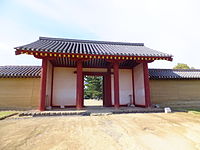Akita Castle
| Akita Castle 秋田城 |
|
|---|---|
| Akita, Akita Prefecture, Japan | |

Reconstructed East Gate of Akita Castle
|
|
| Coordinates | 39°44′25″N 140°04′46″E / 39.7403°N 140.0794°ECoordinates: 39°44′25″N 140°04′46″E / 39.7403°N 140.0794°E |
| Type | hirayama-style Japanese castle |
| Site information | |
| Owner | 1994-2008 |
| Open to the public |
yes |
| Site history | |
| Built | 780 |
| Built by | Satake Yoshinobu |
| In use | Nara period – Heian period |
| Demolished | 1050 |
Akita Castle (秋田城 Akita-jō?) refers to the ruins of a Nara period fortified settlement located in what is now the city Akita, Akita Prefecture, Japan. It is also sometimes referred to as “Fort Akita”. The name is sometimes also used for Kubota Castle, an Edo period Japanese castle which served as the headquarters or the Satake, daimyō of Kubota Domain, rulers of northern Dewa Province under the Tokugawa shogunate.
During the Asuka period, Abe no Hirafu conquered the native Emishi tribes at what are now the cities of Akita and Noshiro in 658 and established a fort on the Mogami River. In the year 708 AD, “Dewa Country” was created out of the northern half of Echigo Province and was raised in status to Dewa Province in 712 AD. However, at that time the region was still outside the effective control of the Yamato court based in Nara. A number of military expeditions were sent to the area, with armed colonists forming settlements with wooden palisades across central Dewa in what is now the Shōnai area of Yamagata Prefecture. In 733, the fort on the Mogami River was moved north, and a new military settlement, later named “Akita Castle”, was built what is now in the Takashimizu area of the city of Akita. Abe no Yakamaro was sent as Chinjufu Shogun, and Akita Castle became a base of operations to colonize the region and to subdue the native Emishi peoples.
...
Wikipedia
